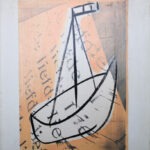COLLECTION ZOOM
Jolande Gerner
BIOGRAPHY
Born
1953 Amstedam
Residence
The Netherlands
Education
Gerrit Rietveld Academie in Amsterdam 1980-1986
Jolande Gerner’s paintings reflect different moods that can change every day. That is why her paintings are never finished. Every time I enter my studio, I see things that need to change. Every time I enter my studio, I see things that need to be changed. ‘Then I take an apple from one painting and put a vase on the other. Every once in a while someone should come here and take the paintings away. Otherwise I keep changing it’.
In this way her paintings become a reflection of all those moods, layer upon layer. Because she paints with transparent oil paint those changes always remain a little visible. Her work is almost like the human character, strongly layered and nuanced, a challenging secret for good ‘understanders’.
At first glance the bright colors stand out with a patina reminiscent of the paintings of the old masters. They certainly influenced her as well. Titian, for example, has used brilliant colors, but the depiction is also very emotional and intimate’.
She is also very impressed by Rothko’s work.’He works a lot with oil paint, the medium par excellence to bring depth into a painting. A world of depth and feeling radiates out of the layer upon layer of applied colors’.
For this reason I also work with oil paint myself. If you use glasis you keep the light in the paint and you get warm, radiant colors. Acrylic, on the other hand, has a deadly effect for me. The advantage of acrylic, however, is that it dries much faster. Working with oil paint requires a lot of attention. The cloths need to be prepared very well and the paint needs a lot of time to dry, otherwise you get craquelees. But that transparency, that light is essential to me’.
Occasionally when she wants to make a color lighter, she uses opaque white. In this way she raises the paint and the colors become even more intense.
Jolande Gerner is a craftsman. She attaches great value to technique and is therefore happy with the knowledge she has gained about it from teachers such as Gordijn and Sierhuis at the Gerrit Rietveld Academie. She feels that in contemporary art too little attention is paid to craftsmanship. For example, Joland never uses ready-made muslin windows. She also stretches the windows herself and prepares the canvases. It may sound strange, but being involved in the process from beginning to end creates a kind of bond with that canvas. To me it’s more than just an ordinary piece of linen. It becomes a personal instrument’.
The objects she paints are everyday; a vase with flowers, a fireplace with apples and pears. Jolande has an eye for small, subtle things. She also makes imaginary vases, which are so beautiful that she would like to have them herself. A dream vase, next to which she paints an apple, because otherwise the vase would be so lost.
She doesn’t concern herself with symbols or ambiguous meanings. She is looking for her own visual language in the paintings. Her preference is for the traditional techniques in combination with mainly figurative representations. However, she has also made abstract work. People say that it is so good and innovative, but that doesn’t interest me. What matters to me is the depth, the intensity. What it represents is not important to me either. All I need now is the figuration in order to reach that intensity’.





